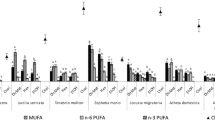Abstract
Thein vitro incorporation of elongated fatty acyl products into various lipid classes was studied in the American cockroach,Periplaneta americana (L.) and the houseflyMusca domestica L. Stearoyl-CoA (18∶0-CoA) and linoleoyl-CoA (18∶2-CoA) were each elongated in microsomal preparations from abdominal epidermal tissue of the adult cockroach. Incorporation of radioactive tracer into different lipid classes was determined by thin-layer chromatography (TLC). In the American cockroach, 40–45% of the total radioactive label was incorporated into the free fatty acid fraction, with smaller amounts in the triglyceride (12–31%) and phospholipid (12–19%) fractions. Of the elongated products analyzed by radio-high performance liquid chromatography (HPLC), 53–60% was found in the free fatty acid fraction. In the housefly, the substrates 18∶0-CoA and 18∶1-CoA were used to determine into which lipids the elongated products would become incorporated. The saturated fatty acyl elongated products were found mainly in the free fatty acid (41%), triglyceride (23%), and acyl-CoA (17%) fractions. The monounsaturated fatty acyl elongated products were found in the triglyceride (44%), free fatty acid (11%), acyl-CoA (35%) and phospholipid (10%) fractions in three-day-old males. In three-day-old females, the elongated products were found in the triglyceride (45%), free fatty acid (28%), acyl-CoA (11%) and phospholipid (15%) fractions. From these data, it is not possible to determine the identity of the substrate for the conversion of the elongated fatty acyl products to the corresponding hydrocarbon (Hy). In the cockroach, incubations with 18∶0-CoA and with 18∶2-CoA resulted in small incorporations into 25∶0 Hy and into 27∶2 Hy, respectively. In the housefly, incubations with 18∶1-CoA resulted in a very small production of 27∶1 Hy in mature males and 23∶1 Hy in mature female houseflies. These data support the idea that the preparation of subcellular fractions results in an uncoupling of fatty acid chain elongation from the conversion of the fatty acid to the corresponding hydrocarbon in both insects.
Similar content being viewed by others
Abbreviations
- HPLC:
-
high performance liquid chromatography
- Hy:
-
hydrocarbon
- TLC:
-
thin-layer chromatography
References
Sandercock, S.P., and Rusell, N.J. (1980)Biochem. J. 188, 585–592.
Pollard, M.R., and Stumpf, P.K. (1980)Plant Physiol. 66, 649–655.
Lessire, R., Juguelin H., Moreau, P., and Cassagne, C. (1985)Arch. Biochem. Biophys. 239, 260–269.
Cripps, C., Blomquist, G.J., and de Renobales, M. (1986)Biochim. Biophys. Acta 876, 572–580.
Wakayama, E.J., Dillwith, J.W., and Blomquist, G.J. (1986)Insect Biochem. 16, 895–902.
Spates, G.E., Elissalde, M., and Williams, H. (1988)Arch. Insect Biochem. Physiol. 7, 47–57.
Kolattukudy, P.E. (1976) inChemistry and Biochemistry of Natural Waxes (Kolattkudy, P.E., ed.) pp. 1–15, Elsevier, Amsterdam.
Vaz, A.H., Blomquist, G.J., and Reitz, R.C. (1988)Insect Biochem. 18, 177–184.
Vaz, A.H., Jurenka, R.A., Blomquist, G.J., and Reitz, R.C. (1988)Arch. Biochem. Biophys. 267, 551–557.
Cheesbrough, T.M., and Kolattukudy, P.E. (1984)Proc. Natl. Acad. Sci. USA 81, 6613–6617.
Cheesbrough, T.M., and Kolattukudy, P.E. (1988)J. Biol. Chem. 263, 2738–2743.
Bergstrom, J.D., and Reitz, R.C. (1980)Arch. Biochem. Biophys. 24, 71–79.
Bligh, E.G., and Dyer, W.J., (1959)Can. J. Biochem. Physiol. 37, 911–917.
Metcalf, L.D., Schmitz, A.A., and Pelka, J.R. (1966)Anal. Chem. 38, 514–516.
Reitz, R.C. (1972)Biochim. Biophys. Acta 260, 654–665.
Budzikiewicz, H., Djerassi, C., and Williams, D.H. (1967)Mass Spectrometry of Organic Compounds, pp. 174–196, Holden-Day, Inc. San Francisco.
Blomquist, G.J., Nelson, D.R., and de Renobales, M. (1987)Arch. Insect Biochem. Physiol. 6, 227–267.
Blomquist, G.J., and Dillwith, J.W. (1985) inComprehensive Insect Physiology and Biochemistry (Kerkut, G.A., and Gilbert, L.I., eds.) Vol. 3, pp. 117–154, Pergamon Press, Oxford.
Blomquist, G.J., Adams, T.S., and Dillwith, J.W. (1987) inPheromone Biochemistry (Prestwich, G.P., and Blomquist, G.J., eds.) pp. 217–250, Academic Press, New York.
Fast, P.G. (1966)Lipids 1, 163–236.
Jurenka, R.A., de Renobales, M., and Blomquist, G.J. (1987)Arch. Biochem. Biophys. 255, 184–193.
Author information
Authors and Affiliations
About this article
Cite this article
Vaz, A.H., Wong, A.G. & Reitz, R.C. In vitro incorporation of elongated fatty acyl products into lipid classes in the housefly,Musca domestica L. and the American cockroach,Periplaneta americana (L.). Lipids 25, 695–700 (1990). https://doi.org/10.1007/BF02544036
Received:
Revised:
Accepted:
Issue Date:
DOI: https://doi.org/10.1007/BF02544036




